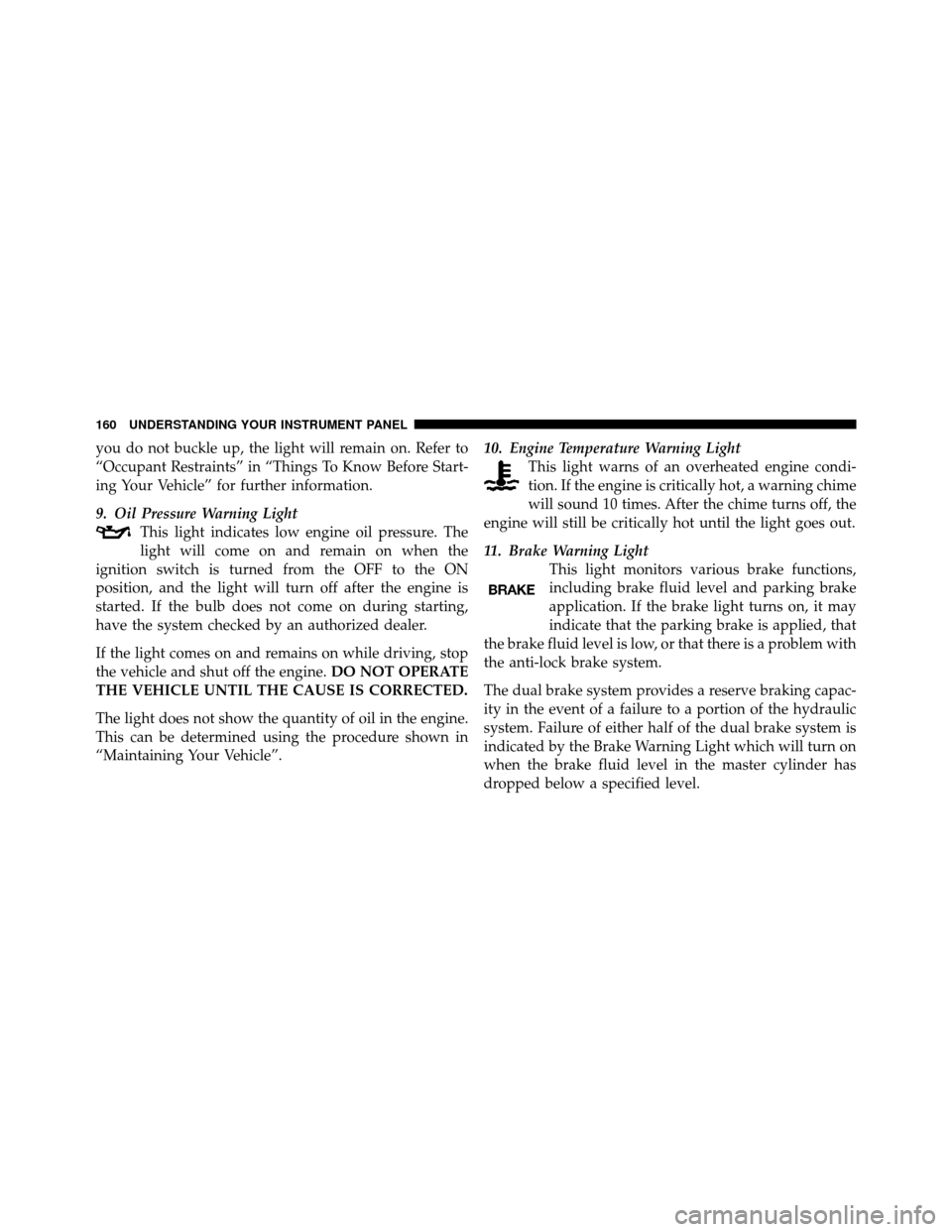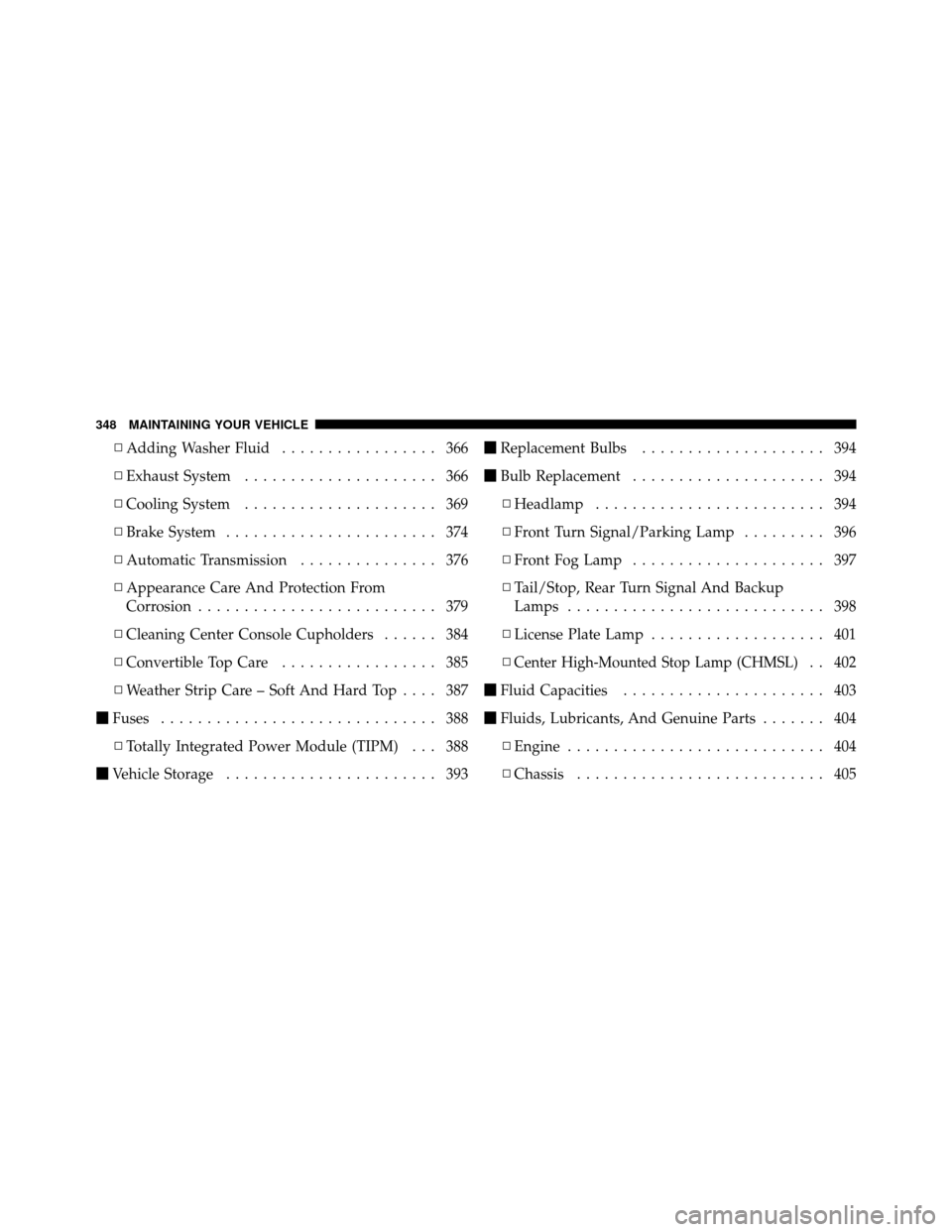Page 83 of 457
Door Latches
Check for positive closing, latching, and locking.
Fluid Leaks
Check area under vehicle after overnight parking for fuel,
engine coolant, oil, or other fluid leaks. Also, if gasoline
fumes are detected or if fuel, power steering fluid, or
brake fluid leaks are suspected, the cause should be
located and corrected immediately.
82 THINGS TO KNOW BEFORE STARTING YOUR VEHICLE
Page 161 of 457

you do not buckle up, the light will remain on. Refer to
“Occupant Restraints” in “Things To Know Before Start-
ing Your Vehicle” for further information.
9. Oil Pressure Warning LightThis light indicates low engine oil pressure. The
light will come on and remain on when the
ignition switch is turned from the OFF to the ON
position, and the light will turn off after the engine is
started. If the bulb does not come on during starting,
have the system checked by an authorized dealer.
If the light comes on and remains on while driving, stop
the vehicle and shut off the engine. DO NOT OPERATE
THE VEHICLE UNTIL THE CAUSE IS CORRECTED.
The light does not show the quantity of oil in the engine.
This can be determined using the procedure shown in
“Maintaining Your Vehicle”. 10. Engine Temperature Warning Light
This light warns of an overheated engine condi-
tion. If the engine is critically hot, a warning chime
will sound 10 times. After the chime turns off, the
engine will still be critically hot until the light goes out.
11. Brake Warning Light This light monitors various brake functions,
including brake fluid level and parking brake
application. If the brake light turns on, it may
indicate that the parking brake is applied, that
the brake fluid level is low, or that there is a problem with
the anti-lock brake system.
The dual brake system provides a reserve braking capac-
ity in the event of a failure to a portion of the hydraulic
system. Failure of either half of the dual brake system is
indicated by the Brake Warning Light which will turn on
when the brake fluid level in the master cylinder has
dropped below a specified level.
160 UNDERSTANDING YOUR INSTRUMENT PANEL
Page 162 of 457

The light will remain on until the cause is corrected.
NOTE:The light may flash momentarily during sharp
cornering maneuvers which change fluid level condi-
tions. The vehicle should have service performed, and
the brake fluid level checked.
If brake failure is indicated, immediate repair is neces-
sary.
WARNING!
Driving a vehicle with the brake light on is danger-
ous. Part of the brake system may have failed. It will
take longer to stop the vehicle. You could have an
accident. Have the vehicle checked immediately.
Vehicles equipped with Anti-Lock brakes (ABS), are also
equipped with Electronic Brake Force Distribution (EBD). In the event of an EBD failure, the Brake Warning Light
will turn on along with the ABS Light. Immediate repair
to the ABS system is required.
The operation of the Brake Warning Light can be checked
by turning the ignition switch from the OFF position to
the ON position. The light should illuminate for approxi-
mately three seconds. The light should then turn off
unless the parking brake is applied or a brake fault is
detected. If the light does not illuminate, have the light
inspected by an authorized dealer.
The light also will turn on when the parking brake is
applied with the ignition switch in the ON position.
NOTE:
This light shows only that the parking brake is
applied. It does not show the degree of brake application.
4
UNDERSTANDING YOUR INSTRUMENT PANEL 161
Page 245 of 457

�Driving On Slippery Surfaces ............. 260
▫ Acceleration ........................ 260
▫ Traction ........................... 260
� Driving Through Water ................. 261
▫ Flowing/Rising Water ................. 261
▫ Shallow Standing Water ............... 261
� Power Steering ....................... 263
▫ Power Steering Fluid Check ............. 264
� Parking Brake ........................ 264
� Anti-Lock Brake System (ABS) ............ 267
� Electronic Brake Control System ........... 269
▫ Anti-Lock Brake System (ABS) ........... 269
▫ Traction Control System (TCS) ........... 270▫
Brake Assist System (BAS) .............. 270
▫ Hill Start Assist (HSA) – If Equipped ...... 271
▫ Electronic Stability Control (ESC) ......... 273
� Tire Safety Information ................. 277
▫ Tire Markings ....................... 277
▫ Tire Identification Number (TIN) ......... 280
▫ Tire Terminology And Definitions ......... 281
▫ Tire Loading And Tire Pressure .......... 282
� Tires — General Information ............. 286
▫ Tire Pressure ....................... 286
▫ Tire Inflation Pressures ................ 287
▫ Radial-Ply Tires ..................... 289
▫ Compact Spare Tire ................... 289
244 STARTING AND OPERATING
Page 263 of 457

CAUTION! (Continued)
•Driving through standing water may cause dam-
age to your vehicle’s drivetrain components. Al-
ways inspect your vehicle’s fluids (i.e., engine oil,
transmission, axle, etc.) for signs of contamination
(i.e., fluid that is milky or foamy in appearance)
after driving through standing water. Do not con-
tinue to operate the vehicle if any fluid appears
contaminated, as this may result in further dam-
age. Such damage is not covered by the New
Vehicle Limited Warranty.
•Getting water inside your vehicle’s engine can
cause it to lock up and stall out, and cause serious
internal damage to the engine. Such damage is not
covered by the New Vehicle Limited Warranty.
WARNING!
•Driving through standing water limits your vehi-
cle’s traction capabilities. Do not exceed 5 mph
(8 km/h) when driving through standing water.
•Driving through standing water limits your vehi-
cle’s braking capabilities, which increases stop-
ping distances. Therefore, after driving through
standing water, drive slowly and lightly press on
the brake pedal several times to dry the brakes.
•Getting water inside your vehicle’s engine can
cause it to lock up and stall out, and leave you
stranded.
•Failure to follow these warnings may result in
injuries that are serious or fatal to you, your
passengers, and others around you.
262 STARTING AND OPERATING
Page 265 of 457

Power Steering Fluid Check
Checking the power steering fluid level at a defined
service interval is not required. The fluid should only be
checked if a leak is suspected, abnormal noises are
apparent, and/or the system is not functioning as antici-
pated. Coordinate inspection efforts through an autho-
rized dealer.
CAUTION!
Do not use chemical flushes in your power steering
system as the chemicals can damage your power
steering components. Such damage is not covered by
the New Vehicle Limited Warranty.
WARNING!
Fluid level should be checked on a level surface and
with the engine off to prevent injury from moving
parts and to ensure accurate fluid level reading. Do
not overfill. Use only manufacturer’s recommended
power steering fluid.
If necessary, add fluid to restore to the proper indicated
level. With a clean cloth, wipe any spilled fluid from all
surfaces. Refer to “Fluids, Lubricants, and Genuine
Parts” in “Maintaining Your Vehicle” for further
information.
PARKING BRAKE
Before leaving the vehicle, make sure that the parking
brake is fully applied. Also, be certain to leave the
transmission in PARK.
264 STARTING AND OPERATING
Page 349 of 457

▫Adding Washer Fluid ................. 366
▫ Exhaust System ..................... 366
▫ Cooling System ..................... 369
▫ Brake System ....................... 374
▫ Automatic Transmission ............... 376
▫ Appearance Care And Protection From
Corrosion .......................... 379
▫ Cleaning Center Console Cupholders ...... 384
▫ Convertible Top Care ................. 385
▫ Weather Strip Care – Soft And Hard Top .... 387
� Fuses .............................. 388
▫ Totally Integrated Power Module (TIPM) . . . 388
� Vehicle Storage ....................... 393 �
Replacement Bulbs .................... 394
� Bulb Replacement ..................... 394
▫ Headlamp ......................... 394
▫ Front Turn Signal/Parking Lamp ......... 396
▫ Front Fog Lamp ..................... 397
▫ Tail/Stop, Rear Turn Signal And Backup
Lamps ............................ 398
▫ License Plate Lamp ................... 401
▫
Center High-Mounted Stop Lamp (CHMSL). . 402
� Fluid Capacities ...................... 403
� Fluids, Lubricants, And Genuine Parts ....... 404
▫ Engine ............................ 404
▫ Chassis ........................... 405
348 MAINTAINING YOUR VEHICLE
Page 350 of 457
ENGINE COMPARTMENT — 2.4L
1 — Engine Coolant Reservoir7 — Air Cleaner Filter
2 — Power Steering Fluid Reservoir 8 — Engine Oil Fill
3 — Automatic Transmission Dipstick 9 — Coolant Pressure Cap
4 — Brake Fluid Reservoir 10 — Engine Oil Dipstick
5 — Integrated Power Module 11 — Washer Fluid Reservoir
6 — Power Distribution Center
7
MAINTAINING YOUR VEHICLE 349